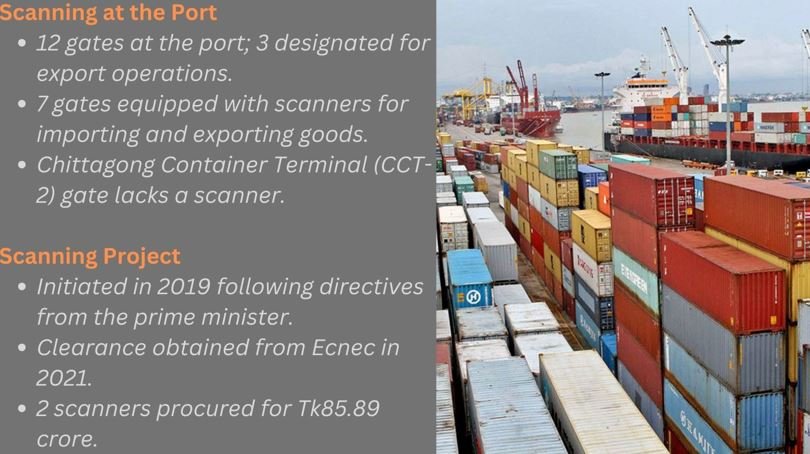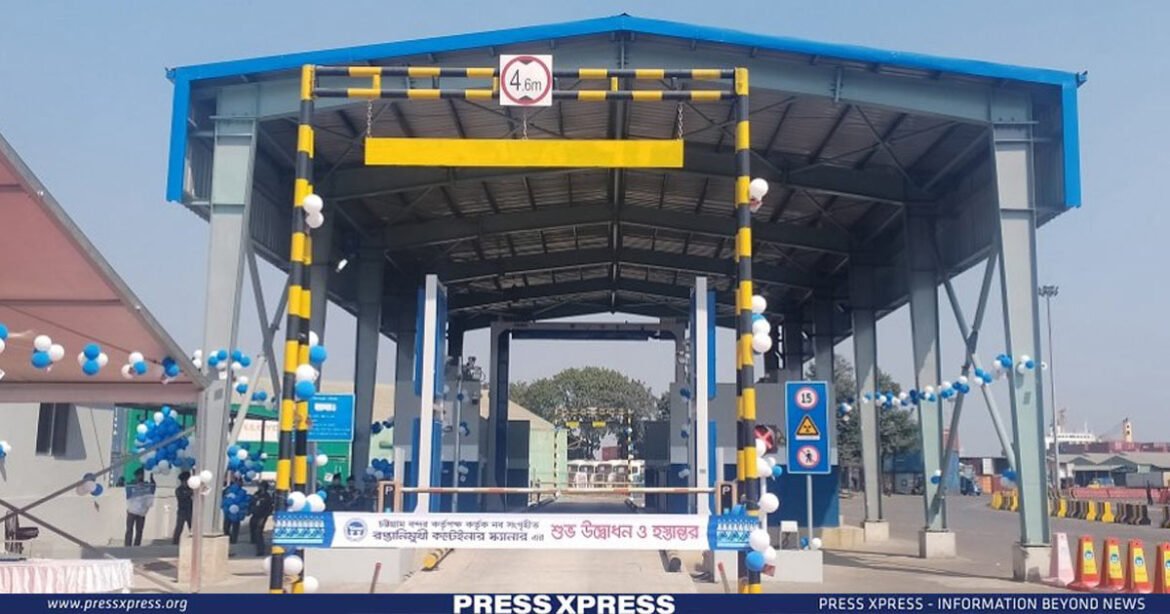Key Highlights:
- Scanners can inspect 150 export containers per hour, boosting operational efficiency
- Automation reduces manual intervention, facilitating smoother logistics operations
- Reliability of export shipments fosters trust among trading partners
- Chattogram Port aligns with the International Ship and Port Facility Security (ISPS) Code
Chattogram Port, often hailed as the heart of Bangladesh’s economy, plays a pivotal role in facilitating trade and commerce not only within the nation but also across the South Asian and other Asian regions. Situated strategically, its geographical location offers a seamless and cost-effective gateway for foreign trade, making it a crucial player in the country’s economic landscape.
You Can Also Read: Walmart’s Interest in Bangladesh Signals a Thriving Partnership
In a significant stride towards enhancing efficiency and security, Chattogram Port has recently introduced two sets of fixed scanners dedicated to export-oriented containers. These scanners mark a significant departure from past practices, aiming to combat false declarations, money laundering, and tax evasion effectively. With the installation of these advanced scanning systems, the port authorities can now scrutinize export containers meticulously, ensuring compliance with regulations and preventing illicit activities.

Enhanced Security Measures
The implementation of these cutting-edge scanners underscores Chattogram Port’s dedication to maintaining global standards of security and integrity. Armed with radioactive portal monitors and advanced image monitoring systems, these scanners not only strengthen security measures but also streamline cargo inspection processes. Through real-time CCTV surveillance and image analysis, port authorities ensure strict oversight, guarding against potential threats and unauthorized activities.
With the ability to scan 150 export containers per hour, these scanners offer a significant boost to cargo handling operations at Chattogram Port. By automating inspections and reducing manual intervention, they facilitate smoother logistics operations and quicker turnaround times. Furthermore, by ensuring the reliability of export shipments, these scanners cultivate trust and confidence among trading partners, thereby facilitating seamless trade relations.
The introduction of fixed scanners not only enhances Chattogram Port’s operational efficiency but also aligns with its broader ambition of becoming a premier maritime hub. By adhering to the International Ship and Port Facility Security (ISPS) Code, the port underscores its commitment to implementing industry-leading security practices. This proactive stance not only elevates the port’s standing on the global platform but also fosters trust among stakeholders, positioning Chittagong Port as the preferred choice for international trade.
Scanning at the Port
At the port, there are a total of 12 gates, but only three are designated for export operations. However, during special events, gates for both export and import functions are selected randomly. Out of the nine gates allocated for importing and exporting goods, seven are equipped with scanners. Besides the two gates primarily intended for export, there’s another entrance focused on exports: the Chattogram Container Terminal (CCT-2) gate, which unfortunately lacks a scanner.

Scanning Project
Regarding the scanner installation project, officials revealed that it was initiated in 2019 following directives from the prime minister. The project received clearance from Ecnec in 2021, and the Shipping Ministry approved the Development Project Proposal the following year, with an initial budget of Tk89.33 crore. Subsequently, an agreement was reached to procure two scanners for Tk85.89 crore.
What does the CPA say?
Regarding the implications of these scanners, officials from the Chattogram Port Authority (CPA) mentioned that apart from enhancing security, they will also lead to reduced commercial expenses. Additionally, they will facilitate multi-agency monitoring, involving the CPA, the National Board of Revenue, and the Custom House, Chattogram. Lt. Col. Mostafa Arif-ur Rahman Khan informed Bangla Tribune that plans are underway to install a scanner at the CCT-2 gate soon. He emphasized that besides identifying risky shipments, the scanners at BCG-4 and CPAR gates will also scrutinize whether illegal containers are being exported and if taxes are being evaded.
Recent Developments in Chattogram Port
Several initiatives have been implemented in recent months to alleviate congestion caused by containers and traffic within the port and to halt the illegal collection of tolls. These measures encompass various actions:
- Removal of all empty containers during nighttime.
- Transporting container shipments to Kamlapur ICD in three shifts instead of two daily.
- Unloading nine specific commodities outside the port.
- Opening port access roads to traffic.
- Disposal of spoiled food and other stagnant items.
- Full container (FCL) collection by importers from the hook point.
- Expansion of off-dock ICD facilities.
- Utilization of an extended area of NCT.
Additionally, steps have been taken to mitigate the undue influence of workers, including:
- Introduction of three shifts for dock workers.
- Restriction of trade union influence.
- Elimination of wage disparities for night shifts.
- Regulation of gang booking by workers.
Further measures undertaken include:
- Repeal of LMD.
- Prevention of illegal toll collection by freight forwarders.
- Prohibition of surcharge/rate restoration charges.
- Adjustment of container transfer and goods transportation fees.
- Cessation of toll collection at the Panama truck stand.
- Complete transfer of CCT operation to a private entity.
- Reduction of container delivery layers through a streamlined one-stop service.
- Abolition of two postings and establishment of new cut-off times.
- However, it is recognized that long-term measures are necessary to address procedural complexities effectively.
In conclusion, the introduction of fixed scanners at Chattogram Port heralds a new era of enhanced security, efficiency, and compliance within Bangladesh’s maritime industry. By leveraging cutting-edge technology and proactive enforcement measures, the port authorities demonstrate their unwavering commitment to fostering a secure and transparent trading environment. Moving forward, sustained efforts in strengthening port infrastructure and regulatory frameworks will be essential in realizing the port’s potential as a leading hub for regional and international trade.


